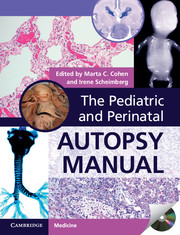Book contents
- Frontmatter
- Contents
- List of contributors
- Foreword
- Preface
- Acknowledgments
- 1 Perinatal autopsy, techniques, and classifications
- 2 Placental examination
- 3 The fetus less than 15 weeks gestation
- 4 Stillbirth and intrauterine growth restriction
- 5 Hydrops fetalis
- 6 Pathology of twinning and higher multiple pregnancy
- 7 Is this a syndrome? Patterns in genetic conditions
- 8 The metabolic disease autopsy
- 9 The abnormal heart
- 10 Central nervous system
- 11 Significant congenital abnormalities of the respiratory, digestive, and renal systems
- 12 Skeletal dysplasias
- 13 Congenital tumors
- 14 Complications of prematurity
- 15 Intrapartum and neonatal death
- 16 Sudden unexpected death in infancy
- 17 Infections and malnutrition
- 18 Role of MRI and radiology in post mortems
- 19 The forensic post mortem
- 20 Appendix tables
- Index
- References
10 - Central nervous system
Published online by Cambridge University Press: 05 September 2014
- Frontmatter
- Contents
- List of contributors
- Foreword
- Preface
- Acknowledgments
- 1 Perinatal autopsy, techniques, and classifications
- 2 Placental examination
- 3 The fetus less than 15 weeks gestation
- 4 Stillbirth and intrauterine growth restriction
- 5 Hydrops fetalis
- 6 Pathology of twinning and higher multiple pregnancy
- 7 Is this a syndrome? Patterns in genetic conditions
- 8 The metabolic disease autopsy
- 9 The abnormal heart
- 10 Central nervous system
- 11 Significant congenital abnormalities of the respiratory, digestive, and renal systems
- 12 Skeletal dysplasias
- 13 Congenital tumors
- 14 Complications of prematurity
- 15 Intrapartum and neonatal death
- 16 Sudden unexpected death in infancy
- 17 Infections and malnutrition
- 18 Role of MRI and radiology in post mortems
- 19 The forensic post mortem
- 20 Appendix tables
- Index
- References
Summary
Introduction
This chapter provides a practical guide to examination of the fetal, infant, and child’s brain. It covers those conditions most likely to be encountered in daily diagnostic practice and indicates practice points and pitfalls. More detailed texts are referred to for further reading.
Autopsy examination and removal of the brain
The parental wishes and their authority to examine the brain are paramount prior to neuropathological examination. This is a sensitive topic and must be broached with parents at a time when they are grieving. A careful and empathetic approach usually results in consent to examine the brain. In order to make the best possible diagnosis, with the opportunity to revisit the diagnosis and to use tissue for later teaching and research, it is necessary to request permission for the brain to be retained after diagnosis has been made. Parents are usually extremely generous if this need is explained, but their wishes should always be fully respected. It is almost always possible to accommodate both the parents’ requirements for tissue return for burial and comprehensive brain examination by expediting fixation (for example by using extra-strength formalin). While not ideal, this may be a worthwhile compromise so that the best possible diagnostic service can be offered while remaining sensitive to parents’ wishes.
- Type
- Chapter
- Information
- The Pediatric and Perinatal Autopsy Manual , pp. 173 - 204Publisher: Cambridge University PressPrint publication year: 2000
References
- 2
- Cited by

